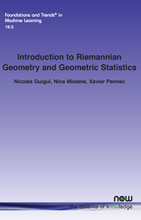Introduction to Riemannian Geometry and Geometric Statistics: From Basic Theory to Implementation with Geomstats
By Nicolas Guigui, Université Côte d’Azur, Inria, France, nicolas.guigui@inria.fr | Nina Miolane, University of California Santa Barbara, USA, ninamiolane@ucsb.edu | Xavier Pennec, Université Côte d’Azur, Inria, France, xavier.pennec@inria.fr
Abstract
As data is a predominant resource in applications, Riemannian geometry is a natural framework to model and unify complex nonlinear sources of data. However, the development of computational tools from the basic theory of Riemannian geometry is laborious. The work presented here forms one of the main contributions to the open-source project geomstats, that consists of a Python package providing efficient implementations of the concepts of Riemannian geometry and geometric statistics, both for mathematicians and for applied scientists for whom most of the difficulties are hidden under high-level functions. The goal of this monograph is two-fold. First, we aim at giving a self-contained exposition of the basic concepts of Riemannian geometry, providing illustrations and examples at each step and adopting a computational point of view. The second goal is to demonstrate how these concepts are implemented in Geomstats, explaining the choices that were made and the conventions chosen. The general concepts are exposed and specific examples are detailed along the text. The culmination of this implementation is to be able to perform statistics and machine learning on manifolds, with as few lines of codes as in the wide-spread machine learning tool scikit-learn. We exemplify this with an introduction to geometric statistics.
Introduction to Riemannian Geometry and Geometric Statistics: From Basic Theory to Implementation with Geomstats
As data is a predominant resource in applications, Riemannian geometry is a natural framework to model and unify complex nonlinear sources of data. However, the development of computational tools from the basic theory of Riemannian geometry is laborious.
In this monograph the authors present a self-contained exposition of the basic concepts of Riemannian geometry from a computational viewpoint, providing illustrations and examples at each step. They proceed to demonstrate how these concepts are implemented in the open-source project Geomstats, explaining the choices that were made and the conventions chosen. The reader thus learns in one self-contained volume the theory of Riemann geometry and geometric statistics and their implementation to perform statistics and machine learning on manifolds.
Containing many practical Python examples, this monograph is a valuable resource both for mathematicians and applied scientists to learn the theory of Riemann geometry and its use in practice implemented with the Geomstats package where most of the difficulties are hidden under high-level functions.
